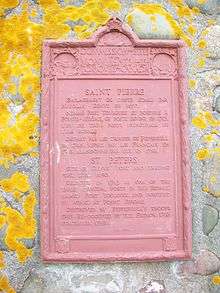Siege of Port Toulouse
| ||||||||||||||||||||||||||||||||||
The Siege of Port Toulouse took place between May 2–10, 1745 when a New England colonial force aided by a British fleet captured Port Toulouse (present-day St. Peter's, Nova Scotia) in the French colony of Île-Royale (present-day Cape Breton Island) from its French defenders during the War of the Austrian Succession, known as King George's War in the British colonies.[2]
Prelude
Port Toulouse was of strategic importance to the French because it was the closest settlement to the British occupied mainland Nova Scotia and it was the closest base to the Mi'kmaq.[3] Mi'kmaq chiefs came to Port Toulouse annually for their alliance renewal with the French not only from Île-Royale but also from the mainland.[4] The two greatest ongoing royal expenditures in the southeastern corner of Île-Royale had to do with maintaining the alliance with the Mi'kmaq and with keeping Port Toulouse defensible. The two were inter-connected.[5] Port Toulouse was also the logical location for the French to launch attacks against the British at Canso.[6] Port Toulouse was home to a garrison of 23 soldiers of the Compagnies Franches de la Marine.[7] Port Toulouse was only one of two places on Ile Royale, outside of Louisbourg, assigned any kind of military capability.[8] There were modest earthworks and a palisade at Port Toulouse.[9] The approximately 200 Acadians who were there began vacating the village in the fall of 1744 after the French attack on Canso.[10] Pierre Maillard led a mission of Mi'kmaq at St. Peter's during this time of about 80 families.[11]
Battle

The New England expedition set sail from Boston in stages beginning in early March 1745 with 4,200 soldiers and sailors aboard a total of 90 ships. The force was under the command of William Pepperrell of Kittery (in the portion of the Massachusetts colony that is now the state of Maine), and a fleet of colonial ships was assembled and placed under the command of Captain Edward Tyng.
The force stopped at Canso to reprovision and there they were met by Commodore Peter Warren, enlarging the expedition by 16 ships. In late March, the naval forces began to blockade Louisbourg just as the ice fields were being swept from the Gulf of St. Lawrence to the seas off Louisbourg.
On May 2, Pepperell sent Jeremiah Moulton with 70 soldiers and two vessels to capture the fortified village of Port Toulouse. The New Englanders were only able to capture a single sloop and burn a few houses before being repelled by the French soldiers, Acadians and Mi'kmaq. They wounded three New Englanders when they were retreating.[12] Eight days later, on May 10, the New Englanders returned with a force four times larger – 270 men. They burned every standing structure at Port Toulouse, demolished the fort, and desecrated a cemetery where Mi'kmaq were buried.[13] Some French were killed in the assault and others were taken prisoner.[14]
Aftermath

New Englanders proceeded to destroy Petit-de-Grat, Isle Madame, and Nerichac (Arichat, Nova Scotia).[15] The New Englanders then besieged Louisbourg itself. Following 47 days (6 weeks and 5 days) of the siege, the French capitulated on June 17, 1745. The Acadians who escaped from Port Toulouse made their way to the Isthmus of Chignecto at Beaubassin and Quebec. The Acadians returned in 1749, after the war ended, to Port Toulouse in greater numbers. They were deported again after the second Siege of Louisbourg (1758). After the fall of Louisbourg, the thousands of Acadians who remained on Île-Royale were deported to France.[16]
See also
- Military history of Nova Scotia
- Military history of the Mi’kmaq People
- Military history of the Acadians
References
- ↑ p. 23
- ↑ Johnson, A.J.B. Storied Shore. University College of Cape Breton Press. 2004.
- ↑ Johnson, p. 53
- ↑ Johnson, p. 54
- ↑ Johnson, p. 87
- ↑ Johnson, p. 55
- ↑ Johnson, p. 89
- ↑ The other was present-day Englishtown, Nova Scotia. Johnson, p. 88
- ↑ Johnson, p. 89
- ↑ Johnson, p. 52
- ↑ https://archive.org/stream/documentsrelativ10brod#page/16/mode/2up/search/acadia
- ↑ George A. Rawlyk. Yankees at Louisbourg: The Story of the First Siege, 1745. Brenton Books. 1999., p. 64
- ↑ Pierre Malliard. An account of the customs and manners of the MicMakis and Marichetts Savage Nations
- ↑ Johnson, p. 68
- ↑ Johnson, p. 69
- ↑ Johnson, p. 70
Bibliography
Primary Sources
- Johnson, A.J.B. Storied Shores: St. Peter's, Isle Madame and Chapel Island in the 17th and 18th Centuries. University College of Cape Breton Press. 2004.
- Pepperrell to Shirley April 1745
